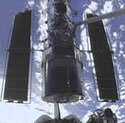
Image credit: NASA
Nearly 48 hours after launching from Cape Canaveral, the space shuttle Columbia caught up with the Hubble Space Telescope, grabbed it with the Canadarm and linked up. After the Sunday morning link up, the astronaut crew activated the motors that retract Hubble’s solar panels – unused since 1993, they performed flawlessly. Astronauts John Grunsfeld and Rick Linnehan will begin their first spacewalk on Monday to install new solar arrays.
The Hubble Space Telescope is secure in Columbia?s payload bay following its capture at 3:31 a.m. central time today, as the two spacecraft soared 350 miles above the Pacific Ocean southwest of the Mexican Coast.
Columbia?s chase of the telescope ended with Commander Scott Altman and Pilot Duane Carey manually flying Columbia to within 35 feet of Hubble allowing Mission Specialist Nancy Currie to use the shuttle?s robot arm to gently grasp the orbiting observatory.
With the telescope safely in the payload bay, the crew turned its attention to retracting the two large solar arrays that generate power for the telescope. The motors that drive the two arrays had not been used since the panels were originally deployed during the first servicing mission in December 1993. The motors performed flawlessly taking approximately five minutes to retract each of the two arrays. The retractions were scheduled to take place during orbital daytime to allow sunlight to adequately warm the arrays prior to retraction.
The first in a pair of new-generation solar arrays will be installed by John Grunsfeld and Rick Linnehan on the first scheduled spacewalk of the mission, which is set to begin about 12:30 a.m. Monday. However, it is possible the spacewalk could begin up to one hour earlier than scheduled.
The crew is scheduled to wake up about 8 p.m. today, and within hours Grunsfeld and Linnehan, with the assistance of crewmates Jim Newman and Mike Massimino, will begin donning their spacesuits. They will begin the spacewalk by setting up some of the tools they will use, before Grunsfeld and Linnehan, working together, remove the old array, stow it in the payload bay and install the new starboard side array. They will also install its associated electrical support components, called a Diode Box Assembly. Mission Control bid the crew goodnight just before noon today concluding a busy and successful day culminating with the capture of the Hubble Space Telescope. The next STS-109 mission status report will be issued Sunday evening following crew wake-up or as events warrant.
Original Source: NASA News Release
